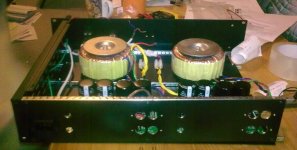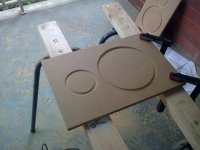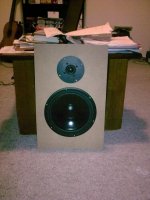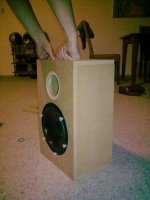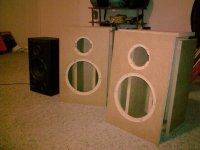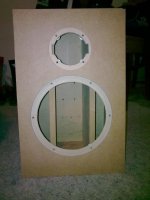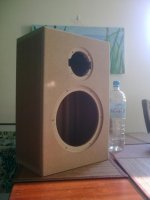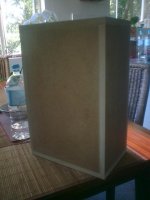Hi all 🙂
I'm a beginner in loudspeaker design, and have in mind a 2-way closed-box with one SEAS CA22NRX woofer.
The woofer manufacturer published the following TS parameters:
- fs = 29 Hz
- Vas = 97 l
- Qms = 2.04
- Qes = 0.52
I cannot measure these parameters myself, but found here Poor Man' these numbers:
- fs = 38.5 Hz
- Vas = 51.84 l
- Qms = 2.27
- Qes = 0.51
If i take the manufacturer parameters, i could end with a 25l enclosure targeting F3 at about 60 Hz.
If i take the second set of parameters, the same procedure will lead to a 13l enclosure with F3 at about 80 Hz...
I can live with the imprecision on fs, but i'm more concerned about the value of Vas. If i make a small enclosure i might get a boomy sound, which i don't want. If i make a larger enclosure i might get really little bass...
Any advice on what i should do: trust the manufacturer, trust the independent measurements or look for some compromise? 🙄
Regards,
chaparK
I'm a beginner in loudspeaker design, and have in mind a 2-way closed-box with one SEAS CA22NRX woofer.
The woofer manufacturer published the following TS parameters:
- fs = 29 Hz
- Vas = 97 l
- Qms = 2.04
- Qes = 0.52
I cannot measure these parameters myself, but found here Poor Man' these numbers:
- fs = 38.5 Hz
- Vas = 51.84 l
- Qms = 2.27
- Qes = 0.51
If i take the manufacturer parameters, i could end with a 25l enclosure targeting F3 at about 60 Hz.
If i take the second set of parameters, the same procedure will lead to a 13l enclosure with F3 at about 80 Hz...
I can live with the imprecision on fs, but i'm more concerned about the value of Vas. If i make a small enclosure i might get a boomy sound, which i don't want. If i make a larger enclosure i might get really little bass...
Any advice on what i should do: trust the manufacturer, trust the independent measurements or look for some compromise? 🙄
Regards,
chaparK
Hi
A second set of measurements.
Thiel & small CA22RNX
Fs = 38.55 Hz
Re = 5.80 ohms[dc]
Le = 1531.29 uH
L2 = 610.14 uH
R2 = 14.78 ohms
Qt = 0.42
Qes = 0.51
Qms = 2.34
Mms = 22.33 grams
Rms = 2.309682 kg/s
Cms = 0.000763 m/N
Vas = 55.23 liters
Sd= 226.98 cm^2
Bl = 7.820266 Tm
ETA = 0.59 %
Lp(2.83V/1m) = 91.23 dB
Closed Box Method:
Box volume = 65.00 liters
Diameter= 17.00 cm
Do not trust the manufacturer.
I think 30L for a closed box ? F3=64Hz. 25L also works .
Regards.
A second set of measurements.
Thiel & small CA22RNX
Fs = 38.55 Hz
Re = 5.80 ohms[dc]
Le = 1531.29 uH
L2 = 610.14 uH
R2 = 14.78 ohms
Qt = 0.42
Qes = 0.51
Qms = 2.34
Mms = 22.33 grams
Rms = 2.309682 kg/s
Cms = 0.000763 m/N
Vas = 55.23 liters
Sd= 226.98 cm^2
Bl = 7.820266 Tm
ETA = 0.59 %
Lp(2.83V/1m) = 91.23 dB
Closed Box Method:
Box volume = 65.00 liters
Diameter= 17.00 cm
Do not trust the manufacturer.
I think 30L for a closed box ? F3=64Hz. 25L also works .
Regards.
My advice is this. The two sets of measurements should have a decent cone mass calculation - average them. Then ignore the VAS and just use the box compliance. Set the F3 that you want from these numbers and you won't be far off.
"Boomy" is mostly the room and placement and has very liuttle to do with the enclosure design.
"Boomy" is mostly the room and placement and has very liuttle to do with the enclosure design.
Hi Jerome, gedlee,
Thanks for your posts and sorry for answering late.
Given that there are two independent sets of measurements that are mostly identical, i'll go for these and discard the manufacturer data. Hope to post here soon more details as i'm going to need more advices 😀
Regards,
chaparK
Thanks for your posts and sorry for answering late.
Given that there are two independent sets of measurements that are mostly identical, i'll go for these and discard the manufacturer data. Hope to post here soon more details as i'm going to need more advices 😀
Regards,
chaparK
Hi all!
I haven't been onto this post for some time. I was busy with the amplifier for my project. It's a 4-channel with Tripath TA2022, one channel per driver.
I know it's not the right place for talking about amplifiers, but well i'm building my whole sound system consisting of DSP + Amp + Speakers, so it's a bit hard to split the project into separate topics.
Here are some pics of the amp (awful picture quality, gee 😱)
I'll be back in a short while with a couple of questions regarding the speaker enclosures!
Best!
chapark
I haven't been onto this post for some time. I was busy with the amplifier for my project. It's a 4-channel with Tripath TA2022, one channel per driver.
I know it's not the right place for talking about amplifiers, but well i'm building my whole sound system consisting of DSP + Amp + Speakers, so it's a bit hard to split the project into separate topics.
Here are some pics of the amp (awful picture quality, gee 😱)
I'll be back in a short while with a couple of questions regarding the speaker enclosures!
Best!
chapark
Attachments
As i wrote in my first post, that's my first loudspeaker project so i'd like to keep it easy and concentrate on sound only.
That's the reason why i've selected a 2-way only design (rather than a 3-way) and that's also why i'm choosing a closed-box enclosure. Maybe that in the future the project will end into a 3-way vented - in the meantime the idea is more about learning some cool stuff about loudspeaker design rather than achieving from scratch the ultimate sound system (oh god where did i learn to flatter old experts like that? 😛 )
Here's a draft of what i have in mind. It's a basic symmetric bookshelf. The drivers are:
- SEAS CA22NRX
- Eton 25SD1
- Is there something fundamentally wrong with my design?
- I'm probably going to mount/unmount the drivers a few times, so i'm not too crazy about self-threading screws (parker style). What's an other good alternative?
- Finally, i heard that it's better for a closed-box not to be too air-tight, so that the atmospheric pressure can easily balance inside and outside. That makes sense to me. What does it mean practically? Where should the air leakage take place?
Thanks all for reading this post!
chaparK
EDIT: forgot to mention that the box will be built with MDF 18mm
That's the reason why i've selected a 2-way only design (rather than a 3-way) and that's also why i'm choosing a closed-box enclosure. Maybe that in the future the project will end into a 3-way vented - in the meantime the idea is more about learning some cool stuff about loudspeaker design rather than achieving from scratch the ultimate sound system (oh god where did i learn to flatter old experts like that? 😛 )
Here's a draft of what i have in mind. It's a basic symmetric bookshelf. The drivers are:
- SEAS CA22NRX
- Eton 25SD1
- Is there something fundamentally wrong with my design?
- I'm probably going to mount/unmount the drivers a few times, so i'm not too crazy about self-threading screws (parker style). What's an other good alternative?
- Finally, i heard that it's better for a closed-box not to be too air-tight, so that the atmospheric pressure can easily balance inside and outside. That makes sense to me. What does it mean practically? Where should the air leakage take place?
Thanks all for reading this post!
chaparK
EDIT: forgot to mention that the box will be built with MDF 18mm
Attachments
Last edited:
Why not use Metric? Are these for T-nuts? Anyway most bolt and nut places should be able to supply. Try Coventry fasteners
Coventry Group
Coventry Group
Why not use Metric? Are these for T-nuts? Anyway most bolt and nut places should be able to supply. Try Coventry fasteners
Coventry Group
Thanks Monndog, they even have a shop in Artarmon which is convenient for me.
Yes the screws are for the nuts and their bloody imperial thread (Hurricane nuts ordered from parts-express).
More work done: braces are now ready.
Beginning of the gluing session:
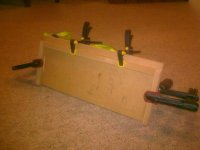
Here's how the braces are supposed to support the front panel:
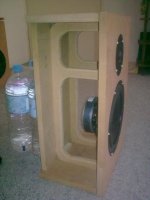
Making sure all parts are adjusted:
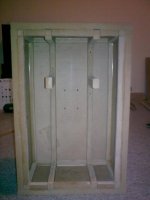
Gluing the enclosure:
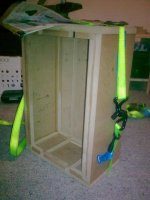
Question: do you guys think i should secure the front panel against the braces with screws, or is the glue bond going to be enough?
Beginning of the gluing session:

Here's how the braces are supposed to support the front panel:

Making sure all parts are adjusted:

Gluing the enclosure:

Question: do you guys think i should secure the front panel against the braces with screws, or is the glue bond going to be enough?
if the cleats the baffle sits on are close fitting and a decent size, and the rest of the joint is pretty snug then glue alone is more than sufficient....especially if you can clamp in a similar way to your other panels during glueing.
First box glued! 🙂 Still need to trim the edges.
Frank, do you know where i can get some of these (at a decent price) ?
chaparK,
To make it neater, try button head Allen screws.
Frank
Frank, do you know where i can get some of these (at a decent price) ?
Happy new year to everybody, wish you all lots of cool audio projects 😀
Finishing the assembling:
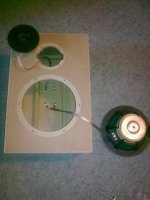
Filling with special acoustic material! OK i admit, that's just pillow stuffing 😉
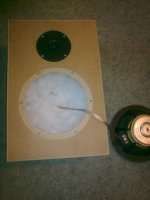
Connecting it all:
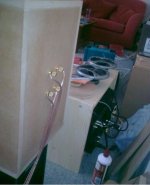
A few experiments with xovers. For now, my favorite is a FIR with about 160 taps generated by the blue processor on top.
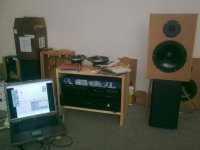
Hm still need to finish the second box, damn! 😛
Finishing the assembling:

Filling with special acoustic material! OK i admit, that's just pillow stuffing 😉

Connecting it all:

A few experiments with xovers. For now, my favorite is a FIR with about 160 taps generated by the blue processor on top.

Hm still need to finish the second box, damn! 😛
The tweeter came with a foam gasket, unlike the woofer. However, the woofer is tightly flush mounted.
Quick question: Do i need to add a gasket between the woofer and the enclosure, or can i neglect the small air leakage here?
Quick question: Do i need to add a gasket between the woofer and the enclosure, or can i neglect the small air leakage here?
So the second loudspeaker is finished. This project took me longer that i initially planned - but that was my first attempt with woodworking power tools such as circular saw and router. Quite a bit of an unknown - and of fun actually 😀
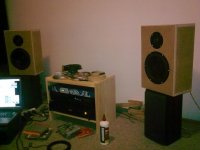
This is what i used for sealing the interface between the woofer and the enclosure. It's a foam tape for sealing windows.
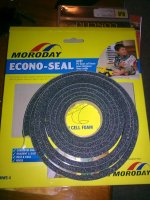
So far i haven't done any measurement. I'm just trying to adjust the system by listening to it. The current setting is a simple FIR of length 169 at 48 kHz with a kaiser window. There's also a slight bass boost (3 dB with corner at 188 Hz). The tweeter is attenuated by 3 dB, but i guess i should attenuate more. I already noticed that i tend to push high frequencies more than others - i'm not too young
The next step is about measuring the system, and implement some filtering. What i have in mind for a start is a Linkwitz transform to replace the bass boost.
(talking about Linkwitz, i was reading yesterday an article he wrote in the beginning of the 80s about his home sound system, and well, based on his recommendations it appeared that he wouldn't like my design. Too bad 🙁 )

This is what i used for sealing the interface between the woofer and the enclosure. It's a foam tape for sealing windows.

So far i haven't done any measurement. I'm just trying to adjust the system by listening to it. The current setting is a simple FIR of length 169 at 48 kHz with a kaiser window. There's also a slight bass boost (3 dB with corner at 188 Hz). The tweeter is attenuated by 3 dB, but i guess i should attenuate more. I already noticed that i tend to push high frequencies more than others - i'm not too young

The next step is about measuring the system, and implement some filtering. What i have in mind for a start is a Linkwitz transform to replace the bass boost.
(talking about Linkwitz, i was reading yesterday an article he wrote in the beginning of the 80s about his home sound system, and well, based on his recommendations it appeared that he wouldn't like my design. Too bad 🙁 )
Attachments
- Status
- Not open for further replies.
- Home
- Loudspeakers
- Multi-Way
- TS parameters & closed-box design



